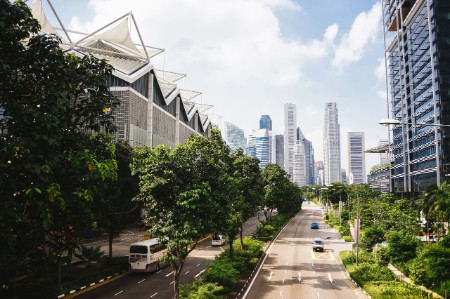
Chapter 1
Attracting talent remains a fundamental strength of GBDs
Building enviroments that attract skilled workers
Although the world’s megacities are being tested by ever increasing populations and the current pandemic crisis, competition among them to attract talent, tourists, technology and capital is ever present. Maintaining attractiveness and cultivating the best possible environments are of paramount importance to foster their growth.
Central to this contest is the war for talent, where there is fierce competition to attract high-quality skills. This strategic factor takes precedence over all other considerations, including the proximity to clients and business opportunities, and the amenities that provide a “work, live and play” environment. The need for high-quality skills is much more than the requirement to secure bespoke and innovative offices.
Current outlook
84%of the executives surveyed believe the ability to attract and retain talent is very important for the attractiveness of business districts.
Among experts interviewed by EY, 84% consider access to highly skilled professionals a fundamental factor of the attractiveness of GBDs, compared with 70% in 2017. According to the EY report, Building the Talent of the Future (pdf), more than a third of the key professional skills sought in 2020 were not considered essential three years before. These skills include customer experience, entrepreneurial skills, risk management and data analytics.
The ease of business interactions in the world’s largest business cities is a decisive factor for their attractiveness. Stakeholders in large business districts emphasize the growing importance of being closest to markets, customers and partners (57% in 2020, an increase of 11 points from 2017). In addition, 40% of respondents considered the urban environment and the overall influence of GBDs to attract talent and clients as very important.
Finally, real estate is considered very important by 14% of respondents which is consistent when compared with the results of the 2017 survey. Companies do not overlook the trends of the real estate market but do consider the built environment as a prerequisite. They examine the real estate market closely after having assessed the overall business climate, influence and urban environment of the business district.

Chapter 2
Prioritizing the environment to attract talent
Climate change is a growing concern
Global awareness of environmental issues has grown drastically. According to ULI’s Emerging Trends in Real Estate®: Europe 2020 report, climate change is expected to have the biggest impact on real estate over the next 30 years. In addition, almost half of the survey respondents say climate change has become a greater risk within their portfolio over the past year and 73% expect it to become even greater over the next five years.
In GBDs, 86% of the EY-ULI survey respondents consider having a diversified and sustainable transport network as their top priority in terms of environmental performance. This preference is followed by efficient resource management (water, energy) at 66% and adding more vegetation to the district (46%).
Current outlook
86%of the executives surveyed believe sustainable and diversified transport is a priority to make business districts effective in the long-term.
The COVID-19 pandemic will bring more attention to companies’ societal roles and responsibilities. Moreover, companies’ increasing efforts to address environmental issues may make societies expect more of such measures in the coming days.
For the generation coming up behind Generation Z, the post-pandemic new normal will just be their “normal.” The impact of this generational shift will likely be quite profound. This generation represents the first digital natives and the first global cohort born into the climate emergency period, making them more focused on climate issues than prior generations.

Chapter 3
Evolving economic outlook and work patterns will modify the GBD
Plan for a different future
Cost reduction, safety measures, adoption of technology and remote working will be the main points of discussion for GBDs in the coming months and years. COVID-19 has already spurred rapid technology adoption, potentially changing the working world. Social and professional distancing is prompting organizations to embrace video conferencing.
Preliminary statistics show that future remote working will rise from its pre-COVID rate of 30%.4 New collaborations and teamwork models could emerge. This process will reframe the nature of work and the role of offices in GBDs. Companies may rethink their real estate strategy and footprint. Since these technologies and work patterns will generate efficiency gains, organizations may retain them beyond the crisis.
The financial impact of the crisis on businesses, including multinationals who represent the bulk of GBD tenants, will be multifaceted. They are required to finance the emergency response along with the mitigation and resilience costs around planning and recovering from the outbreak. Business districts will have to cope with both a lower adoption and an increased obligation to keep the prices down. They will need to foster innovative and healthy workspaces with more collaborative spaces that facilitate social distancing.
However, it is worth recalling that some GBDs already provide competitive costs compared with other regional real estate markets. In Canary Wharf, for example, the average rent is 58% lower than the prime rent in Mayfair. In New York’s Financial District, rents are 41% lower than those in Greenwich Village which has a high-quality office space market. In Paris La Défense, the average rent is 35% lower than the average rent in the Paris CBD.
Corporate occupiers are so preoccupied to attract talent that they are ready to pay more. It is about keeping them happy and productive.
For the time being, companies seem to absorb these higher rent costs, thanks to their parallel cost strategies to offset them. This means that by modifying their real estate use around collaborative, shared and open spaces, businesses have managed to reduce their total office space requirements.

Chapter 4
New global risks facing cities call for resilience strategies
Anticipate risks and collaborate
GBD stakeholders, both private and public, will develop new resilience strategies in a collaborative way, and at a larger geographical and technological scale. In their view, it is a precondition for effectively responding to the many challenges of the coming decade, including political tensions, climatic risks or health crises, such as COVID-19.
The current situation highlights the urgent need to work together to protect public spaces and the economic livelihood of small businesses, such as restaurants and local shops. These risks call for looking beyond the business district and even the city’s borders for solutions. It is a question of thinking about the governance of metropolitan assets on a much larger scale.
For the time being, companies seem to absorb these higher rent costs, thanks to their parallel cost strategies to offset them. This means that by modifying their real estate use around collaborative, shared and open spaces, businesses have managed to reduce their total office space requirements.
As described by the survey, the nature of tomorrow’s risks is varied. It includes health, climatic, economic, technological and social risks. Many recent examples have shown that the entities in large business districts need to better anticipate them and work to ensure the resilience of the business districts. Along with governments, companies may find themselves operating in a world where the safety net expectations of workers and societies have permanently shifted, along with their role in helping provide the safety net.
The relationship between business and government to respond to the needs of citizens in other social areas is also changing. Promoting housing affordability, a report published by ULI in 2020, highlights the importance of the public sector’s leadership to set the vision and framework and the need for greater transparency from the private sector to build trust and enhance collaboration. This will go a long way in addressing societal needs more comprehensively.

Chapter 5
GBDs must become inclusive urban destinations
Create differentiating experiences
The concerns of safety and economic resilience are immediate. And the underlying global megatrends will reshape the attractiveness of GBDs in the future.
According to the professionals interviewed, business districts are increasingly looking to enhance the “multi-use experience” of the areas, not only for employees, but also for inhabitants, tourists and consumers. This intention is obvious in the EY-ULI’s 2017 report and has considerably developed since then. According to the experts interviewed in the GBDs, the COVID-19 crisis will further accelerate this trend to enhance experience once the business districts are back in a “new normal” phase.
It is about transforming the business district into a destination and offering a differentiating experience.
Mobility is seen as a key attractiveness factor for future GBDs: 64% of respondents call for more efficient transport networks, mixed-use spaces (40%), as well as services for workers (29%). Business districts are no longer judged solely on the basis of their economic offering, but more and more as major hubs of social life that focus on community building and placemaking. Health and well-being (28%), and the development of housing (27%) provide additional potential for mixed-use projects.
The key is about creating a “24x7 experience” to amaze and surprise people from the time they leave the metro station to entering the offices. It is about transforming the business district into a destination and offering a differentiating experience.
Summary
Twenty-one business districts around the world employ 4.5m people and are home to millions more, covering nearly 100 million square meters of office space. These business districts were accelerating their efforts to attract more talent, new businesses and capital before the COVID-19 crisis. How are long-term megatrends and a global pandemic challenging the status quo?

